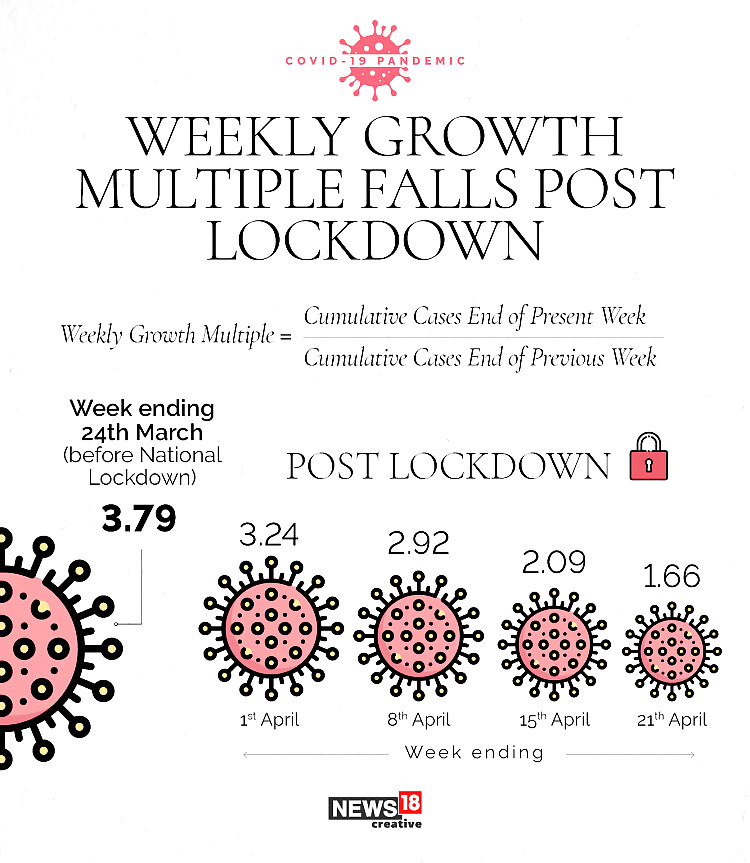
views
On the March 22, a month ago, India observed a ‘Junta Curfew’ or a voluntary lockdown. Two days after the country went into a nationwide lockdown to fight Covid-19, initially for a period of 21 days till the 14th of April. That was extended for another 19 days till May 3, which in effect meant a continuous 40-day lockdown for the second most populous country in the world.
The University of Oxford analyzed 73 countries across the world and ranked India’s lockdown as the ‘strictest’, according to their Stringency Index. The index was based on several factors like travel bans, closure of educational institutes, emergency investment in healthcare, border closure etc and gave the Indian government a score of 100 – indicating that they had taken all the measures to contain the virus.
But were the measures successful?
It has been a month since the Junta Curfew. Despite some major setbacks, which included a significant increase in the number of cases by 'Super-Spreaders' and the issue of migrant workers collecting in their thousands on the streets to go back to their villages, India has done remarkably better than most other major countries of the world.
While there could be several factors responsible for this like the severity of the virus in India, warmer temperature, a large percentage of our population receiving the BCG vaccination, the biggest and the most impactful has been the severe lockdown.
Let us look at some numbers which indicate that the lockdown has been a success:
1) Lockdown vs No Lockdown: Number of cases
According to a study conducted by ICMR, in the absence of a lockdown and containment measures, there would have been 8,20,000 cases by April 15. The projection, with containment measures but no lockdown stood at 1.2 lakh cases. However, the actual number of cases at 9 pm IST on the 15th of April were 12,021.

2) Weekly Growth Multiple
Pre Lockdown:
March 17: 137 cases
March 24 (till before the Lockdown): 519 cases
There was a 279% growth in the number of cases in the week before the lockdown. The number of cases almost quadrupled in 7 days.
The Weekly Growth Multiple (WGM) = Number of cases end of week/Number of cases end of previous.
In the week preceding the lockdown, the WGM stood at 3.79.
Post Lockdown:
March 25: 606 cases
April 1: 1966 cases
April 8: 5749 cases
April 15: 12021 cases
April 21: 20004 cases
Weekly Growth Multiple:
Week ending April 1: 3.24
Week ending April 8: 2.92
Week ending April 15: 2.09
Week ending April 21: 1.66
Thus, we see that the Weekly Growth Multiple (WGM) has gone down from 3.79 in the week before the Lockdown to 1.66 the week ending April 21. The WGM for this week is less than half of the WGM of the last week before the lockdown – this is a massive fall in the rate of growth of cases.
3) Doubling of Cases – Before and After Lockdown
Between March 20 and 23, the cases rose from 223 to 433 – ie 1.94 times in 3 days. After two weeks of the lockdown (Covid-19 is believed to be contagious for 14 days), the cases took approximately six days to double from April 8 to 14 (1.91 times increase).
After two weeks of the lockdown, The President of the Public Health Foundation of India, K Srinath Reddy stated that there is a decrease in the rate of growth of infection in India and social distancing in India has been more effective in India than in many other countries.
This period of doubling has further increased to 7 days from April 14 to April 21 (1.82 times increase).
This was consistent with the findings of the Ministry of Health and Family Welfare.
4) Average Growth Factor
The Average Growth Factor of Covid-19 has slowed down to 1.2% from April 1. It was 2.1% in the two weeks from March 15 to March 31 – a 40% decline in the Growth Factor.
The percentage increase in daily cases has gone down from 12% on April 20 to 9% on April 21 to 6% on April 22.
5) Recovery Rate
India’s Recovery Rate (Total Recovered/Total Cases) has gone up to 19.5% as on April 21. It was at 7% on April 8 and 11.78% on April 14.
Nine states have one third (33%) of their affected cases recovered now. Four states have 50% or more cases recovered.
The Ratio of Recovery/Mortality in India is currently at 86:14.
6) Mortality Rate
The Mortality Rate is the best index for measuring the effectiveness of a lockdown as nothing can be more devastating than the sudden loss of lives.
India’s Mortality Rate has gone down from 3.4 on April 14 to 3.19 on April 22. Amongst the 30 countries with 10000-plus cases, this places India at number 10. Just for perspective, India is better on this count than Germany (3.42), Canada (4.77), USA (5.53), China (5.6), Spain (10.42), France (13.16), Italy (13.4) and UK (13.43) amongst some major powers of the world.
7) Testing Ratios
‘Test Test Test’ – while there is little doubt that the country needs to test more, this has almost become an India-bashing slogan by a certain section of the Western Media and the domestic intelligentsia.
India’s Tests/Cases Ratio stands at 22.92 and is the third-best in the world amongst all countries with 10,000-plus cases only after South Korea and Russia.
India’s Tests/Death Ratio stands at 717.24 and is the seventh-best in the world amongst all countries with 10,000-plus cases only after Singapore, Russia, South Korea, Saudi Arabia, Israel and Chili.
With no lockdown, the number of cases in India would have crossed a million by now with a proportionate increase in the number of deaths too. The country does not have the resources to test millions or the hospital and medical facilities to treat several lakh patients simultaneously – thus, a stringent lockdown was the only effective measure.
8) Rate of Growth Vs Other Countries
India reached its 5000th case on the 7th of April, two weeks after the lockdown. From the 7th of April (Day 0) there have been 14 days till the 21st of April.
We compare the rate of growth of India with some of the worst affected countries from their Day 0 (5000th case) to their respective Day 14.
South Korea: 8320 cases
India: 20004 cases
Iran: 20100 cases
UK: 41903 cases
Italy: 53578 cases
Germany: 62095 cases
USA: 188172 cases
India, has comparatively done better than some of the major countries in the world wrt Rate of Growth of Covid-19 cases.
9) A comparison with other Lockdown Nations
16 of the 25 worst-hit countries in the world had been under a lockdown for at least 3 weeks till April 15. India’s average daily increase in cases during the lockdown places it at Number 7 amongst these 16 countries. India’s average daily increase in cases fell from 21.6% from a week before the lockdown to 15.7% three weeks into the lockdown.
10) Rate of Reproduction – with and without lockdown
According to a study by the Center for Disease Dynamics, Economics and Policy (CDDEP), India’s peak total Covid-19 infections could be reduced by almost 40% with a strict lockdown. The Rate of Reproduction (R) – which is the number of new infections each case leads to – would be at 2.66 without a lockdown. A stringent lockdown like in India can bring this down to as low as 1.5.
All these parameters suggest that India has benefitted significantly by enforcing a strict lockdown at an initial stage much earlier than some of the other Western super-powers of the world.
It almost certainly has averted a disaster of epic proportions!
The Effect on the Poor and other Challenges for the Economy
The greatest challenge that India faces with a stringent lockdown is to save the livelihoods of millions of its poor and marginalized – from migrant workers to small farmers to the urban and rural poor.
A study published mid April suggested that while 300 people had died of Covid-19, there were 200 deaths as a result of the drastic lockdown itself. While the government should have forecasted some of the human damage amongst the weakest sections of the country and made adequate arrangements before announcing a lockdown, the scale and magnitude of this exercise and the expanse and population of India coupled with its inequalities made this a herculean task.
Also, while determining the human cost of the lockdown, we must also consider the level of destruction, both in terms of the spread of the virus and subsequent deaths should such a stringent lockdown not have been imposed. It does not require rocket science to understand that the maximum impact of such colossal damage would have been on the poor – many times more than the numbers being reported today as the human cost of the lockdown.
The other big challenge for India is the adverse effect of the lockdown on the economy. A study conducted estimated that India could lose 13.6 crore jobs and the economy may see its first contraction in 40 years as a result of the lockdown.
An added worry for India is that most of the biggest hotspots in the country are also economic powerhouses and big urban affluent cities like Delhi, Mumbai, Pune, Chennai, Kolkata, Ahmedabad, Jaipur to name a few and are unlikely to see any relaxation in lockdown measures even after the 3rd of May.
Over the next few weeks and months, India would have to strike the right balance between an effective lockdown and keeping the economic engine of the country running – which is essentially maintaining a balance between saving lives and livelihoods.
But for now the world's most stringent lockdown has worked.
And while the elite may scoff as much as they like, it all started in our balconies with the banging of Taalis and Thaalis!
















Comments
0 comment